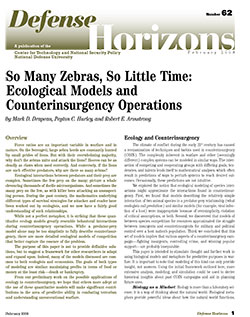DOWNLOAD PDF
 Overview
Overview
Force ratios are an important variable in warfare and in
nature. On the Serengeti, large zebra herds are constantly hunted
by small prides of lions. But with their overwhelming majority,
why don’t the zebras unite and attack the lions? Hooves can be as
deadly as claws when used correctly. And conversely, if the lions
are such effective predators, why are there so many zebras?
Ecological interactions between predators and their prey are
complex. Sometimes the few prey on the many; picture a whale
devouring thousands of docile microorganisms. And sometimes the
many prey on the few, as with killer bees attacking an unsuspecting
person. During the past century, the mathematics underlying
different types of survival strategies for attacker and evader have
been worked out by ecologists, and we now have a fairly good
understanding of such relationships.
While not a perfect metaphor, it is striking that these quantitative
ecology models greatly resemble behavioral interactions
during counterinsurgency operations. While a predator-prey
model alone may be too simplistic to fully describe counterinsurgency,
there are more detailed ecological models of competition
that better capture the essence of the problem.
The purpose of this paper is not to provide definitive solutions,
but to suggest a framework for other researchers to adapt
and expand upon. Indeed, many of the models discussed are common
to both ecologists and economists. The goals of both types
of modeling are similar: maximizing profits in terms of food or
money at the least risk—death or bankruptcy.
From our preliminary work on the possible applications of
ecology to counterinsurgency, we hope that others more adept at
the use of these quantitative models will make significant contributions
to the area of predictive ability in combating terrorism
and understanding unconventional warfare.
READ MORE >>